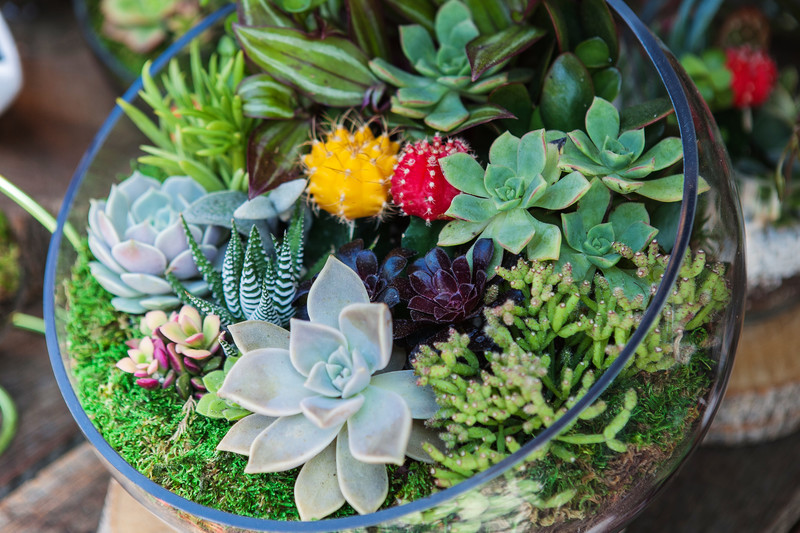Terrarium-Interior decoration trend
Covid times have seen various challenges, various new hobbies being explored to keep oneself engaged and busy. Whether that be saree challenges or making of a dalgona coffee, new trends and fads have emerged and got popular. While people have learned skills as to moving backway for mopping as against front ways while sweeping, others have cultivated hobbies that could turn into a profession like those of home bakers and cloud kitchen owners. Making of terraria is a new trend that many people have taken to in these times, as a means to keep them occupied at the same time make their houses look beautiful with a touch of green.
A terrarium is referred to usually as a sealed glass container that would contain soil and plants. This container may be opened to access the plants for maintenance. However, the terrarium could also be open instead of being sealed so that it has access to the atmosphere. These are essentially like mini glasshouses and are used for decorative purposes within the houses. The sealed containers replicate the water cycle environment so that water from soil can evaporate due to the heat within the sealed environment and then condense back onto the plants as the temperature cools down. The plants usually chosen are slow-growing plants. Thus a terrarium is an ideal microenvironment that promotes the growth of a plant and looks nice and is used for ornamental use in the decoration of the house.
Like many things, the terrarium was initially made as an accident. Botanist Nathaniel Bagshaw Ward is credited with stumbling on the first terrarium purely as an accident. Ward is believed to be have been keenly interested in insect behavior. One of the jars he used for keeping insects was accidentally left unattended. A fern spore germinated into a plant within the jar and grew. Thus was formed the first terrarium. Taking it a step forward, Ward came up with cases in which he exported typical British plants by ship to Sydney in Australia and vice versa. The fact that the plants reached, either way, safe and in good condition proved plants could thrive in a sealed environment, without ventilation. Thus became the popularity of terraria.

There are essentially two types of terraria that are popular. Depending on the environment terraria are either closed or open.
Varieties of plants typical to tropical conditions are usually grown in a closed environment, where the natural environment is replicated. Plants typical for such terrarium are air plants, orchids, and mosses. The sealed environment normally allows the circulation of water within the terrarium. If there is a lack of condensation forming on the wall sides of the container the soil might need to be watered. The soil used for such a closed terrarium is a special soil mix called peat lite. Care is taken to keep the environment sterile so that other microbes don’t grow inside the terrarium.
For plants that are prevalent in more arid regions are better suited for terraria of the open kind. Also, these suit plants which require direct sunlight. An open terrarium unlike a closed one doesn’t trap the heat inside the container. It is to be noted that although a popular choice, succulents like cacti are not best suited for the terraria. The lack of drainage in terraria tends to cause root rot which is why they don’t survive well in terraria. if however succulents are used, they are always in open ones and the soil mix has a higher content of sand in it.
While making a terrarium for the house, the first step is in choosing the container in which to make the terrarium. Although plastic containers are also usable, the look and feel of glass containers are ideally suited for making a terrarium. Starting with pickle jars to pasta containers any glass container will do. We are using a pickle jar for our terrarium. The wide bowl of the pickle jar will not only help in the growth of the plant but also in accommodating decorative elements like seashells and colored pebble to make the terrarium more decorated. The next most important step in making the terrarium is choosing the right plant. Any number of slow-growing and small plants can be used for making a terrarium. Plant moss, Lucky bamboo, ferns are ideal for making a terrarium. We will use a fern for the terrarium we make.
The first step in making the terrarium after the container and plant are identified is to set up a drainage layer in the container. As there is no drainage system, we will need to first set that up. A 2″ layer of stones is first lined on the base of the container. This is now covered by an inch layer of sheet moss. This will help soak up water whenever there is excess. It is to be remembered that shallow jars like ours will need a thinner layer of drainage, while narrower containers will need a thicker layer. To help drainage further we add a ½ inch layer of activated charcoal on this moss layer. This also helps control any bad odors from the soil. To ensure that the main potting soil mix is separated from the activated charcoal we now add a layer of moss. The layering will also help increase the visual appeal especially on account of the difference of color.
Now using a trowel a layer of sterile all-purpose potting mix is added and layered evenly. The layer thickness should be about 2 to 3 inches. Care is taken though so that once the plant is potted in this the layer is low enough for the plant not to touch the terrarium top. If we are interested in contouring the soil with mounds and dips on the soil surface to increase the visual appeal of the terrarium, it is primarily done at this stage. The soil is now ready for the plants.
From the nursery pots in which the plants have been brought in or grown, the roots are gently teased out. A bit of the root may be pruned off so that the growth of the plants is stunted in the terrarium. This is necessary as the space within the terrarium is a confined one and hence cannot support the rapid growth of the plant. The excess soil is now shaken off and the plant root is inserted in the potting soil mix. Since we are using a pickle jar this is not so difficult and easily achieved. If however, a narrower neck doesn’t allow easy access, then the plant may be inserted using tongs. A cork embedded on the tongs is then used to pat down the soil and ensure there are no air pockets between the soil and the roots. For our jar, we just dig holes and after inserting the root use our hands to pat down the soil around it. Using a spray bottle we now spray some water on the soil, just enough to dampen the soil and not make it moist. The terrarium is essentially ready.
The next step is to decorate the terrarium. Using the spray gun water is sprayed on the inside wall of the container and the dirt from the glass is washed and cleaned off using newsprint. Decorative items like colored pebbles, seashells, and figurines may now be added to decorate the terrarium. We now close it off with the top of the pickle jar. To maintain the terrarium the most important thing is to ensure the soil is not too dry nor moist beyond being damp. The condensation on the glass wall is regularly checked and if there is excess as might happen if there is excess water, then the lid is opened so that the same may dry off. The terrarium should anyways be aired out once a month. The damaged and yellowing plants are pruned off and ensured to be cleaned off if it falls on the soil so that it doesn’t decompose and turn into manure. The plant is also pruned occasionally to ensure stunted growth. Fertilizers and manures are not added so that the growth can be controlled.
A terrarium is like a well-cooked meal, that appeals to the senses. Not just the beauty of the green within the house but also the creativity of the maker in the way the terrarium is styled is on display. A well-maintained terrarium is a labor of love though it isn’t a very high maintenance affair, as it is borne out of the aesthetic sense of the creator. So pick your container, fetch your plant, wiggle those green fingers. Happy potting.






